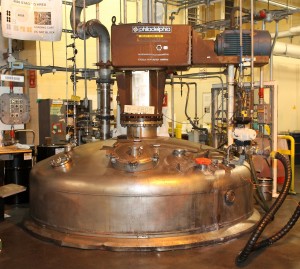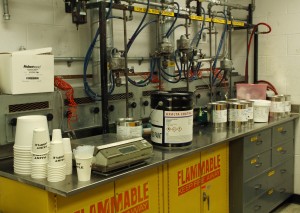Axalta Coating Systems is renewing its focus on India by doubling the production capacity and increasing OEM activity
Text: Bhushan Mhapralkar
The Carlyle Group acquired Dupont’s Performance Coatings business in February 2013 for USD 4.9 billion and rechristened it as Axalta Coating Systems. The Indian operations, as part of the global acquisition, also changed their name to Axalta. Positioning itself as a global supplier of coatings to the transportation and industrial sectors, Axalta, in India, is planning to double the production capacity at its Savli plant (Vadodara), and increase the OEM thrust. Working with a clear objective to deliver performance that exceeds expectation, it creates consistently, quality products that keep operations moving smoothly and application procedures simple. As a result of it, the company bagged a supplier excellence award from Volvo Buses India last year.
Apart from doubling capacity at Savli, Axalta will also invest in an automotive OEM coatings development laboratory at the same location. The project is scheduled to go on stream by the third quarter of 2017, and result in the capacity expansion of both, high and low temperature bake coatings. Of the 2, the low temperature bake coatings find use in the painting of lightweight plastic and composite materials, which is currently used widely in passenger vehicles and two-wheelers to reduce fuel consumption. Such components are unable to withstand traditional high bake temperature curing ovens.
While the coatings that find use in automobiles are largely classified as high bake and low bake, they are also classified as primers, basecoats, and clearcoats, and are made from the use of high solids, high solids 3-wet, and high solids monocoat technologies. Axalta is also keen to leverage its relations as a global supplier of coatings to OEMs like Ford and Daimler. According to Charles W Shaver, Chairman and CEO, Axalta Coating Systems, a part of the company’s expansion initiative is the plan to scale up the production of water borne paints. OEMs incline more towards water borne paints, for environmental and cost reasons. These coatings, according to Shaver, are formulated to reduce volatile organic compound (VOC) emissions. They also help to reduce the environmental impact of coatings while providing superior finishes and improved OEM productivity.
Eyeing 25% growth over the next 5 years, Axalta in the Asia-Pacific region has invested a good deal in China and has rooted its significant presence there. “Before joining hands with Dupont, India was a maintained market as far as the coatings business was concerned. We changed the strategy 2 years ago. We are becoming active; reviewing our strategy and plans. We are meeting a lot of customers in India, especially on the transportation side. We did not do much with OEMs in India because we had a capacity constraint. The situation is rapidly changing as we invest; we will continue to invest in this country. We were looking at the economy to stabilise. We also see some ‘macros’ going our way,” asserted Shaver.
He drew attention to the fact that they want to support the complete spectrum of automobiles in India in their pursuit for growth, especially at the OEM end of the business. In the Indian aftermarket (refinish market), Axalta has had a successful run.
For the Indian market, the capacity expansion and setting up of the OEM lab are expected to help attract OEMs. Expected to be operational by the second quarter of 2016, the OEM lab will feature contemporary robotic spray applicators that can precisely replicate line application conditions. Even the equipment is designed to facilitate the development, approval, quality control and customer line support required by OEMs. Additional new capabilities would include color measurement tools and accelerated paint testing equipment. Expressed Shaver, “The market is changing. It is moving from solvent borne coatings to high solids and waterborne coatings. We have the best technology in the world for that, and we are bringing some of it to India. We are reproducing a majority of our coatings here. We already have the global specs, and this puts us in a good position for exports.” The OEM lab will also mark an expansion of the application center, which has been supporting the aftermarket refinish segments.
Spending USD 200 million for R&D and tech support, Axalta’s stress on dedicated coatings for each vehicle types as the specs differ from region to region. Though coatings for a truck or a bus may mean usage under similar operating conditions, their formulation may differ in terms of their UV properties, clear coat properties, scratch resistance and impact resistance. Coatings may look the same but differ in properties where one would be the high bake type and the other would be the low bake type. Stressing upon the fact that coatings chemistry can differ from one product to another, Shaver explained, “The change in technology to water borne coatings is not just about taking the solvent out, but also about improving productivity. It is possible to speed up the process, go wet-on-wet, and use less quantity. Even a lot of refinish markets world over are shifting to waterborne technologies as they can paint more cars, have quicker color match, and use less oven. So, its not just to do with the regulatory need,” he added.
Shaver also pointed at the raising use of composite parts in autos with expectations for deeper and clearer coats. He expressed, “In the case of OEMs, the demand for longevity, hardness, UV resistance is rising. In the aftermarket, the requirement is to be able to match the color, to match the clarity, and withstand the competition. We are thus way ahead of the regulatory needs.”
After separation from Du Pont, Axalta according to Shaver has moved up a good deal on the innovation front; the coatings major grew 6% in volume terms globally. Profitability grew by 20% almost. Good growth beginning 2013 has been purely organic in nature. The big changes the company effected over the last 3 years include product expansion with a strong focus to invade the main stream. Creation of new technology mediums like water borne coatings, lay stress upon new products at the right price point. Axalta has also developed a whole new range of products that are truly redesigned. In India, the American coatings specialist hopes to grow faster than the market is expected to grow.
According to Shaver, the company has been quite successful in reformulations in the bus segment in the form of low bake coatings that it offers to Volvo, Tata Marcopolo, etc. Trucks are more high-bake, and includes a rising use of plastic components. Claiming to be the second largest powder coatings company in the world, Axalta surprisingly does not have a presence in this respective segment in India. Renewing focus on India after China, Brazil, Mexico and Germany, Axalta
is keenly looking at India as an export base.
A 100% supplier to Tata Group’s Jaguar Land Rover according to Shaver, Axalta’s refinish business amount s more than the OEM business. The refinish business amounts to over USD 2.2 billion, the OEM business amounts to USD 1.4 billion. With the inclusion of commercial vehicles, it amounts to USD 1.7 million. Apart from passenger vehicles, trucks and buses, Axalta eyes on two-wheelers, off-highway equipments and looks for a growth of 5 to 7% at the top and 10% at the bottom. In India, Axalta wanted to grow in double digit. Axalta core markets, said Shaver, could grow anywhere between 9-10%. While input costs, currency stability and inflation will matter in terms of exports. Axalta is hoping that the country would make a significant export base going forward, both in terms of coatings as well as vehicles painted with their coatings. Despite investing in China, Shaver opined, that they feel the country will lose its export potential over time. He drew attention to the fact that raw material costs, labor costs and government costs in China are going up. “They are beginning to look a lot like US,and they are not low cost anymore,” concluded Shaver.














Leave a Reply